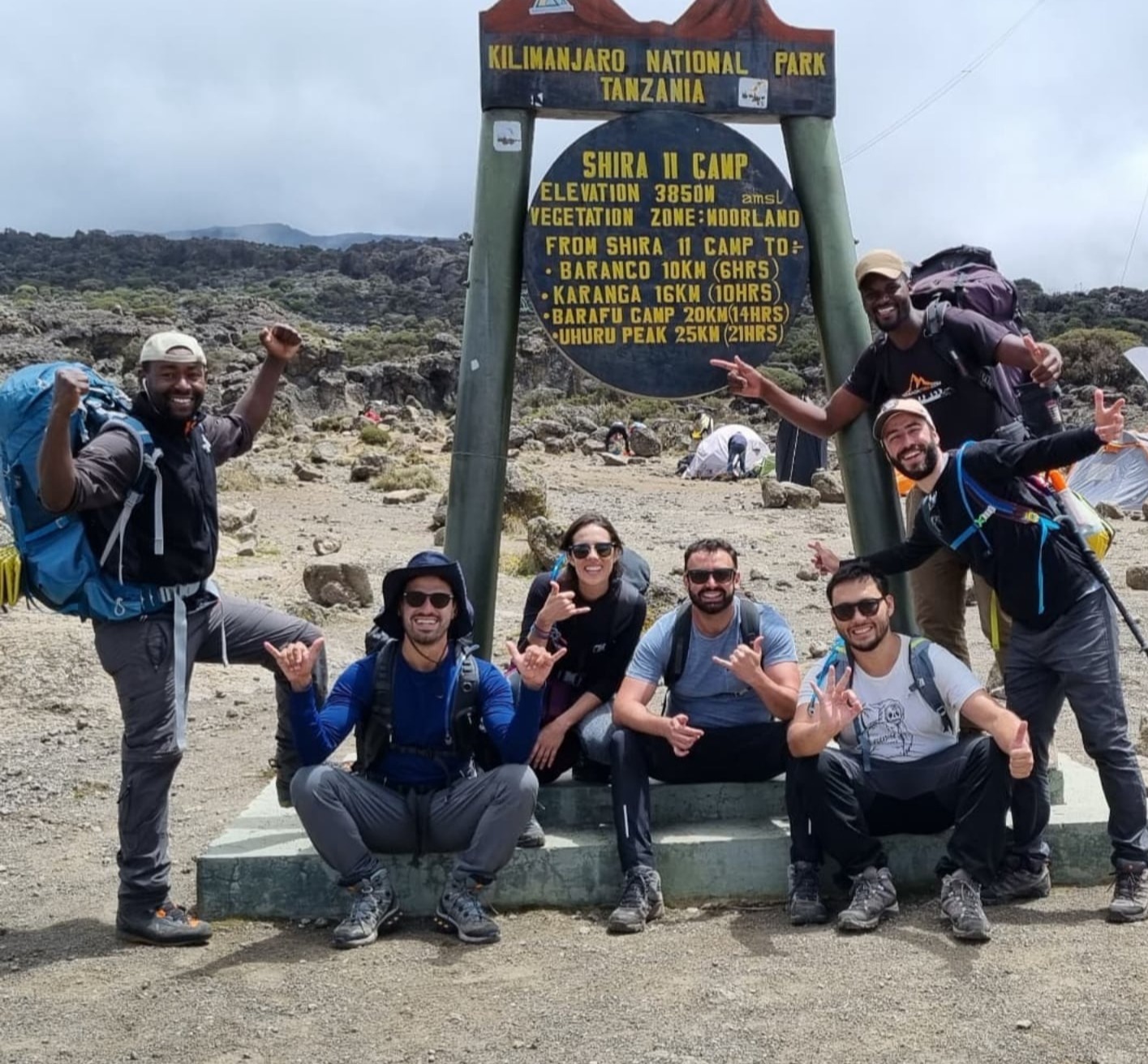Northern Circuit Route Itinerary
Orbit Kilimanjaro- A Day-by-Day Travelogue
Upon arrival at Kilimanjaro International Airport, you will be transferred to your accommodation where your guide will meet you for a full briefing and equipment check.
- Overnight Simba Farm Lodge (Classic) or Ndarakwai Ranch (Premium)
- Lemosho Trailhead (2,400m/7,880ft) to Big Tree Camp (2,800m/9,190ft)
- Elevation Gain:400m/1,310ft
This morning you will drive to the Londorossi gate where you will complete entry formalities and start the trailhead. From here your drive continues for around 1 hour to the Lemosho trailhead.
Enjoy lunch before commencing your Mount Kilimanjaro trek through lush undisturbed forest where you may be lucky enough to see Colobus monkeys.
The path undulates, steeply in places, to arrive at the first camp after 2-3 hours of trekking.
- Overnight Big Tree Camp (Mti Mkubwa)
- Big Tree Camp (2,800m/9,190ft) to Shira 1 Camp (3,550m/11,650ft)
- Elevation Gain:750m/2,460ft
Your Kilimanjaro Climb will begin in the forest; however, you will soon leave it behind, taking a steep track into a zone of giant heather and volcanic rock.
This is a full day ascending the lush rolling hills below the Shira Plateau. Shira is the third of Kilimanjaro’s volcanic cones.
The trail begins to ease as you reach the edge of the plateau, reaching camp after 5-6 hours. The view of Kibo across the plateau is incredible
- Overnight Shira 1 Camp
- Shira 1 Camp (3,550m/11,650ft) to Shira 2 Camp (3,850m/12,650ft)
- Elevation Gain: 300m/1,000ft
Trek across the Shira Plateau with an optional climb to Shira Cathedral (3,880m). Shira is one of the highest plateaus on earth.
The day finishes with a gradual climb to Shira 2 Camp Kilimanjaro. Trekking time without the optional excursion is approximately 3 hours.
Including acclimatization to the peak of Shira Cathedral will add approximately 1 hour.
- Overnight Shira 2 Camp
- Shira 2 Camp (3,850m/12,650ft) to Moir Huts (4,200m/13,780ft) via Lava Tower (4,600m/15,090ft)
- Elevation Gain:750m/2,400ft
- Elevation Loss:400m/1,310ft
Your climb today will take you steadily up and over the expansive ridge lines of the high desert to Lava Tower. The trek to the base of the tower, a 300-foot-high volcanic plug, takes around 4-5 hours.
From Lava Tower Kilimanjaro head northwest beginning your circuit of Kibo, the almighty summit cone of Mount Kilimanjaro. Moir Huts is an isolated and seldom used camp, affording views over the Shira Plateau.
- Total trekking time approximately 6-7 hours.
An alternative would be to take a gentle ascent across the alpine desert to Moir Huts in the morning and spend the afternoon on a guided trek of the nearby Lent Group, a series of wind-eroded parasite cones from which you can gaze down to the plains of Kenya.
- Overnight Moir Huts
- Moir Huts (4,200m/13,780ft) to Buffalo/Pofu Camp (4,020m/13,190ft)
- Elevation Gain:180m/590ft
Today, you will continue your journey through the striking alpine desert. If you didn't visit the Lent Group yesterday, consider a short detour this morning to the summit of Little Lent Hill, which stands at an elevation of 4,375m (14,350ft), showcasing the impressive Mount Kilimanjaro Elevation.
After this, you'll rejoin the main trail heading towards Buffalo Camp. The total trekking time today spans approximately 5 – 7 hours and covers a distance of 12km.
- Overnight Buffalo/Pofu Camp
- Buffalo/Pofu Camp (4,020m/13,190ft) to Third Cave Camp (3,870m/12,700ft)
- Elevation Loss:150m/490ft
Continue your journey, traversing valleys and hiking along ridges, moving through the alpine desert and moorland as you circle towards the east.
This less frequented route showcases the expansive wilderness of the mountain, offering a peaceful exploration of the natural environment.
The trek also offers a unique perspective on the impressive Kilimanjaro Height. Expect today's trekking time to be between 5 - 7 hours.
- Overnight Third Cave Camp
- Third Cave Camp (3,870m/12,700ft) to School Huts (4,750m/15,580ft)
- Elevation Gain:880m/2,880ft
Climb steadily to reach the saddle, a lunar landscape between the peaks of Kibo and Mawenzi. From here, continue upwards to reach School Hut Campsite in the early afternoon.
The remainder of the day is spent resting and preparing for your summit ascent, which will begin in the early hours of the morning.
Despite the short distance of 5km covered, trekking time is approximately 4-5 hours due to the high Kilimanjaro Altitude and steep incline.
- Overnight School Huts
- School Huts (4,750m/15,580ft) to Uhuru Peak (5,895m/19,340ft) then descending to Mweka Camp (3,110m/10,200ft)
- Elevation Gain: 1,145m/3,760ft
- Elevation Loss: 2,785m/9,140ft
Around midnight, begin the final ascent to Uhuru Peak, the highest point in Africa.
For the next six hours, hike by the light of your flashlight. The ascent to the crater rim is the most challenging part of the entire trek.
The trail consists mostly of steep switchbacks, with a rocky section known as Jamaica Rocks to scramble over as you approach the crater rim at Gilman's Point (5,756m).
The hike from here to Uhuru Peak is gradual and, as far as hikes go, not very difficult. The altitude however makes it feel long and tiring.
After summit celebrations descend from the rim at Kilimanjaro Stella Point, to Barafu Camp, and then straight down to Mweka Hut, with lunch served on the way.
This part of the descent takes about 6 hours, covering new terrain. Enjoy your last dinner on the mountain and a well-earned sleep.
- Overnight Mweka Camp
- Mweka Camp (3,110m/10,200ft) to Mweka Gate (1,830m/6,000ft)
- Elevation Loss: 1,280m/4,200ft
Descend to the gate through lush forest (2-3 hours), looking for monkeys along the way. You will be collected from Mweka Village and taken to your hotel in Moshi.
- Overnight Ameg Lodge (Classic) or Pink Flamingo Boutique Hotel (Premium)
Today you will be transferred to Kilimanjaro Airport in time for your flight, or if you’ve decided to extend your Tanzanian adventure, begin the next part of your journey!

